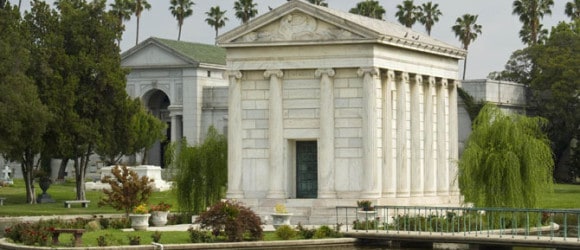Classical Revival Mausoleum: Mausoleum Styles and Architecture
- At March 21, 2013
- By Doug Keister
- In Doug Keister's Blog
0

The most common type of mausoleum architecture is Classical Revival. It is easy to identify by its columns and column capitals, which are classified into “orders,” generally recognized as Doric, Tuscan, Ionic, Corinthian and Composite. Doric and Tuscan architecture developed about the same time, but most scholars think that Doric, despite having more ornamentation, emerged first.
Doric architecture can be divided into Grecian Doric and Roman Doric. The best known Doric building is the Parthenon, built in Athens around 450 B.C.. Doric architecture is identified by its tapering, fluted columns that rise directly from the base (stylobate) and are crowned by plain capitals. Roman Doric columns are also fluted and crowned by plain capitals, but have a base.
Tuscan architecture is a stripped-down form of Doric architecture. The columns on a Tuscan building are smooth, with a notable absence of ornamentation.
Ionic architecture, developed around 600 B.C., is characterized by relatively slender fluted columns that have a molded base. The column capitals are surmounted by a volute (a spiral, scroll-shaped ornament). Architects assign more feminine characteristics to the Ionic form. When writing about his design of the Manger mausoleum in Woodlawn Cemetery, Bronx, New York, architect Franklin Naylor wrote in flowery prose: “. . . Ionic columns are used in the portico, as they are feminine in character, architecturally speaking; the volutes in the capitals represent the curls in the hair of the sex. It [the Ionic form] is also repeated in the pediment overhead, right below the statue. On account of making this entrance entirely feminine, it is very appropriate, since man can only enter the portal of death by being born of woman.”
The most ornamental of all of the orders is Corinthian and its hybrid cousin, Composite. The Corinthian order was an Athenian invention from around 500 B.C., but it was developed into its full ornamentation by the Romans. In pure examples of Corinthian columns, the column capitals are carved representations of leaves of the acanthus, one of the plants most often associated with funerary architecture. Its leaves represent overcoming the trials of life and death. Caught up in the allusions to nature in the Corinthian capitals, designers and carvers often added chirping birds, flowers, ferns, and other assorted flora and fauna to the acanthus leaves. When Ionic volutes are added to the design, the capitals officially cross the line from Corinthian to Composite.
Text and photo © Douglas Keister Visit Doug’s Author Page
